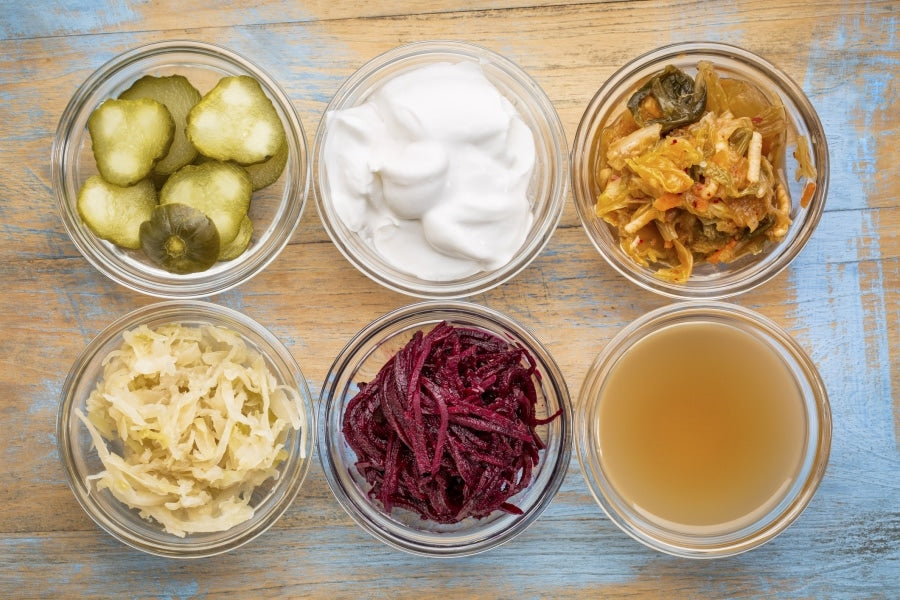
Fermented Foods: A Quick Q&A
Traditional foods are making a huge comeback these days, and one of the trends that makes me happiest is the return to fermented foods.
From kimchi to sauerkraut to kombucha, these foods have been part of human history for centuries—and with good reason! While they may seem humble, they’re super-stars that supply us with the beneficial gut bugs we need to keep our metabolism and immune system operating at their best.
So I’m delighted to hear from more and more of you that you’re adding these foods back into your diet. And today, I’d like to help out by answering some of the top questions I’m asked about them. Here they are.
Fermented vs. pickled foods—what’s the difference?
Pickling refers to preserving foods in an acid medium such as vinegar. That’s perfectly fine, but preserving foods in this way does not cultivate good bacteria. In fact, the pickled products in jars on your store shelves are pasteurized and contain no live bacteria at all.
Fermentation, in contrast, involves preserving foods in a salt brine. This fosters the growth of good bacteria, while the salt in the brine prevents the formation of bad bacteria.
Because fermented foods are perishable, you’ll find them in the refrigerated section in your store. But even refrigeration doesn’t guarantee that they’re fermented, so read the labels carefully to make sure you’re getting what you want. Fermented foods will be preserved in a salt brine, not in vinegar.
Also, don’t just go by brand name. For instance, Bubbie’s kosher dill pickles are fermented, but the same brand’s bread-and-butter chips are pickled in vinegar. So again—read those labels!
What about kefir and kombucha—and how about yogurt?
Both kefir and kombucha are popular right now, and both of them are great ways to add probiotic power to your diet. Here’s a look at each one:
- Kefir is made from milk or coconut milk that’s fermented with a combination of bacteria and yeasts. I strongly recommend reaching for coconut kefir rather than dairy kefir, because milk causes severe problems for a lot of people—from bloating to diarrhea to skin breakouts. (Also, coconut kefir is fine on my Bone Broth Diet, while dairy kefir isn’t.)
- Kombucha is a combination of tea and some form of sugar (for instance, honey) that’s similarly fermented to produce beneficial bacteria.
As for yogurt, it’s also helpful when it comes to populating your microbiome with good bugs. Again, I recommend avoiding dairy-based yogurt and opting for coconut yogurt instead. Also, look for yogurt that’s free of sweeteners and artificial ingredients.
How much, how often?
When you first start eating fermented foods, it may take a while for your body to adjust to them. (That’s because you’re actually changing your gut’s ecosystem.) So I recommend starting with a spoonful or so per day—or about a quarter-cup of kefir, kombucha, or coconut yogurt—and working up to a bigger serving.
Eventually, see if you can get in the habit of eating a good-sized serving every day. For instance, have a cup of coconut kefir, or half a cup of sauerkraut or kimchi, or a whole fermented pickle. If you’re like most people, you’ll go from saying “ugh” to loving these foods, as your body realizes that they’re good for you.
If you have a sustained severe reaction to probiotic foods, you may be dealing with an issue like small intestinal bacterial overgrowth (SIBO). In this case, you may want to abstain from probiotic foods until you heal your gut with a healthy, natural, low-carbohydrate diet and daily bone broth.
Can I make my own probiotic foods?
Yes, you can! What’s more, it’s fun and fairly inexpensive to ferment your own foods. And it’s amazing how many foods you can ferment, from green beans to carrots to okra.
If you want to get serious about it, I recommend books like Nourishing Traditions by Sally Fallon and Mary Enig and The Art of Fermentation by Sandor Ellix Katz (which won a James Beard award).
I’ll probably learn to love probiotics, but right now I’m having trouble getting used to them. Do you have any ideas?
You bet! Try sneaking them into recipes like these:
- Coconut kefir smoothies—blend your kefir with your favorite fruits and veggies.
- Kombucha fruit snacks—check out this fun recipe from Homemade Mommy.
- Coconut kefir ice cream pops—here’s a how-to from Meghan Telpner.
Also, try mixing just a tiny bit of sauerkraut or kimchi into scrambled eggs, stews, soups, or condiments. One tip: When you cook with sauerkraut or kimchi, add it at the last minute and warm it over very low heat to avoid killing those beneficial bugs.
—
No matter how you prefer to eat fermented foods, whether it’s boldly or sneakily, be sure to make them part of your daily diet. And if you haven’t tried them yet, give them a chance, and I think you’ll grow to love them. Like bone broth—another forgotten healing food that we’re rediscovering—fermented foods are nutritional powerhouses that deserve a starring role in a healthy diet!
Keep thinking Big and living BOLD!








